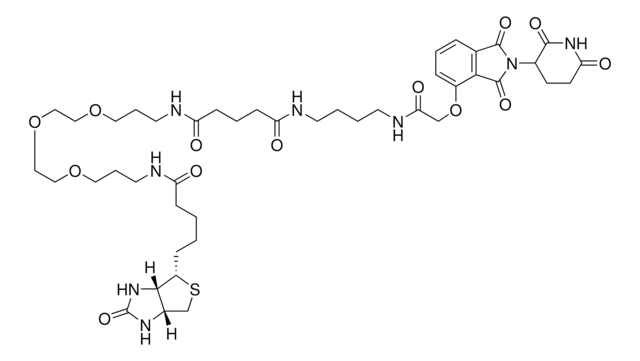914924
3-[2-N-(Biotinyl)aminoethyldithio]propanoic acid
≥95%
Sinónimos:
3-((2-(5-((3aS,4S,6aR)-2-Oxohexahydro-1H-thieno[3,4-d]imidazol-4-yl)pentanamido)ethyl)disulfaneyl)propanoic acid, Biotin-SS-COOH, Cleavable biotin linker
About This Item
Productos recomendados
Nivel de calidad
Análisis
≥95%
formulario
powder
mp
172-175 °C
temp. de almacenamiento
−20°C
InChI
1S/C15H25N3O4S3/c19-12(16-6-8-25-24-7-5-13(20)21)4-2-1-3-11-14-10(9-23-11)17-15(22)18-14/h10-11,14H,1-9H2,(H,16,19)(H,20,21)(H2,17,18,22)/t10-,11-,14-/m0/s1
Clave InChI
LUKYYZVIDAWYMZ-MJVIPROJSA-N
Aplicación
Automate your Biotin tagging with Synple Automated Synthesis Platform (SYNPLE-SC002)
Otras notas
A Mechanism-Based ICAT Strategy for Comparing Relative Expression and Activity Levels of Glycosidases in Biological Systems
Dissociation-independent selection of high-affinity anti-hapten phage antibodies using cleavable biotin-conjugated haptens
Producto relacionado
Código de clase de almacenamiento
11 - Combustible Solids
Clase de riesgo para el agua (WGK)
WGK 3
Punto de inflamabilidad (°F)
Not applicable
Punto de inflamabilidad (°C)
Not applicable
Elija entre una de las versiones más recientes:
Certificados de análisis (COA)
Lo sentimos, en este momento no disponemos de COAs para este producto en línea.
Si necesita más asistencia, póngase en contacto con Atención al cliente
¿Ya tiene este producto?
Encuentre la documentación para los productos que ha comprado recientemente en la Biblioteca de documentos.
Nuestro equipo de científicos tiene experiencia en todas las áreas de investigación: Ciencias de la vida, Ciencia de los materiales, Síntesis química, Cromatografía, Analítica y muchas otras.
Póngase en contacto con el Servicio técnico



![Spiro[9H-fluorene-9,9′-[9H]xanthene]-2,7-diamine](/deepweb/assets/sigmaaldrich/product/structures/307/234/46c07f0c-9242-4c0b-8994-8121690da3c9/640/46c07f0c-9242-4c0b-8994-8121690da3c9.png)



